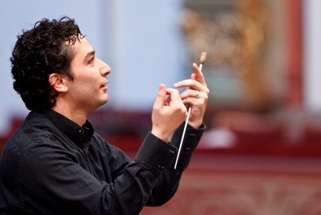|
Back
Fiery Fare Houston
Jones Hall
01/03/2014 - & January 4, 5*, 2014
Joseph Haydn: Symphony No. 59 in A Major, “Fire”
Alfred Schnittke: Moz-Art à la Haydn
Wolfgang Amadeus Mozart: Symphony No. 41 in C Major, “Jupiter”
Eric Halen (violin), Jennifer Owen (violin)
Houston Symphony, Andrés Orozco-Estrada (conductor) 
Andrés Orozco-Estrada (© Werner Kmetitsch)
From the sound of it, the Houston Symphony is enamored with its new music director, and this bodes well for a memorable 2014 in Jones Hall. Andrés Orozco-Estrada kicked off the New Year with a trio of performances that combined charisma from the podium with virtuosity from the orchestra.
The focus on two Classical symphonies added a further feather to Orozco-Estrada’s cap, which was already impressive after his last pair of concerts, which focused on Romantic standards. In both the Haydn and the Mozart symphonies, rhythmic precision gave forward thrust to outer movements while subtle phrasing was added to the mix to make slow movements lyrical but not ponderous. Orozco-Estrada’s time in Vienna has given him a good feel for the natural lilt that can make the dance movements of Austrian symphonies infectious. The finale of Haydn’s “Fire” Symphony was notable for the fine, high horn playing, precisely placed by the duo. Mozart’s “Jupiter” finale, a whirlwind of contrapuntal wizardry, brought incisiveness and a zippy tempo, but the playing was clean enough to maintain clarity even in the coda’s celebrated fugue.
Between the two symphonies, Schnittke’s divertissement was an excellent addition of “spice” to the program. Orozco-Estrada spoke from the podium as the piece was set up, and led the audience in singing “Twinkle, Twinkle” in round to demonstrate Schnittke’s use of canon in the piece. Eric Halen and Jennifer Owen were wholly-dedicated soloists, and their impassioned playing spread to the small double string orchestra standing behind them. The theatrical aspects of the piece betray its 1970s vintage, but the inclusion of a relatively recent work that maintained the levity and grace of its counterparts was excellent programming.
With the orchestra’s 2014-15 season announcement coming in a few days, one looks forward to more intriguing programs that promise to shed further light on Orozco-Estrada’s depth and strengthen his already impressive bond with his new orchestra.
Marcus Karl Maroney
|